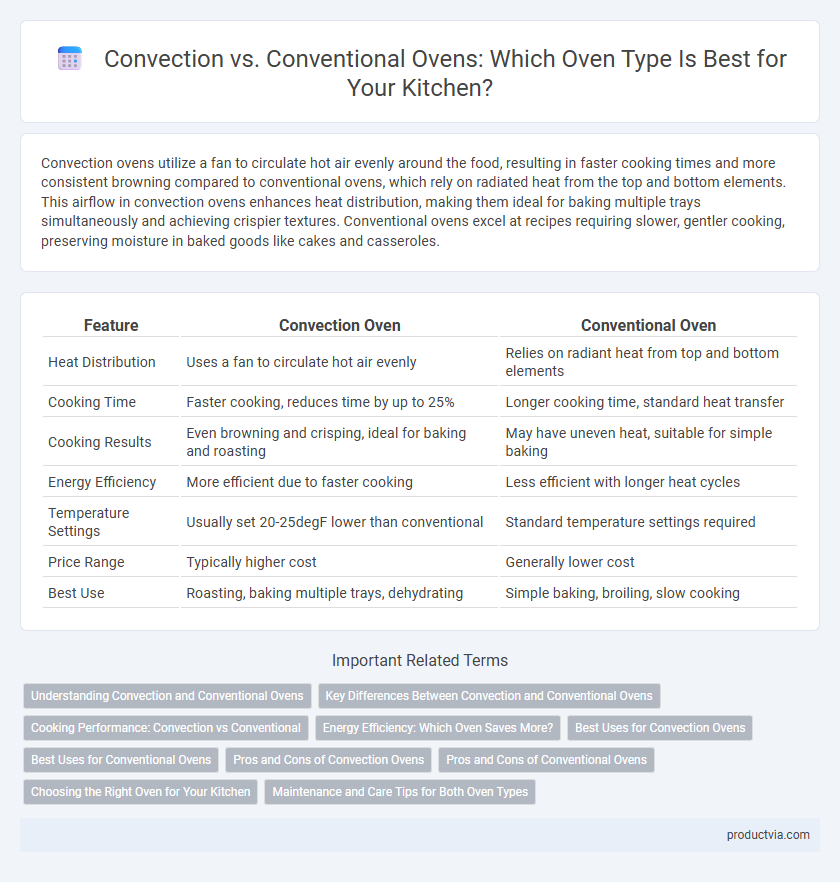Convection ovens utilize a fan to circulate hot air evenly around the food, resulting in faster cooking times and more consistent browning compared to conventional ovens, which rely on radiated heat from the top and bottom elements. This airflow in convection ovens enhances heat distribution, making them ideal for baking multiple trays simultaneously and achieving crispier textures. Conventional ovens excel at recipes requiring slower, gentler cooking, preserving moisture in baked goods like cakes and casseroles.
Table of Comparison
| Feature | Convection Oven | Conventional Oven |
|---|---|---|
| Heat Distribution | Uses a fan to circulate hot air evenly | Relies on radiant heat from top and bottom elements |
| Cooking Time | Faster cooking, reduces time by up to 25% | Longer cooking time, standard heat transfer |
| Cooking Results | Even browning and crisping, ideal for baking and roasting | May have uneven heat, suitable for simple baking |
| Energy Efficiency | More efficient due to faster cooking | Less efficient with longer heat cycles |
| Temperature Settings | Usually set 20-25degF lower than conventional | Standard temperature settings required |
| Price Range | Typically higher cost | Generally lower cost |
| Best Use | Roasting, baking multiple trays, dehydrating | Simple baking, broiling, slow cooking |
Understanding Convection and Conventional Ovens
Convection ovens use a fan to circulate hot air evenly, resulting in faster and more consistent cooking compared to conventional ovens, which rely on radiant heat from heating elements. The advanced air circulation in convection ovens enhances browning and crisping, making them ideal for roasting and baking delicate pastries. Conventional ovens, favored for their straightforward operation, provide a traditional cooking experience with slower, more uniform heat suited for casseroles and baked goods that require gentle cooking.
Key Differences Between Convection and Conventional Ovens
Convection ovens use a fan to circulate hot air, ensuring even cooking and faster baking times compared to conventional ovens, which rely on stationary heating elements. Conventional ovens typically have a more humid cooking environment, which is ideal for baking bread and casseroles, while convection ovens provide a dry heat suitable for roasting and achieving crispy textures. Temperature settings often need adjusting, with convection ovens requiring lower temperatures to prevent overcooking due to efficient heat distribution.
Cooking Performance: Convection vs Conventional
Convection ovens utilize a fan to circulate hot air, resulting in faster and more even cooking compared to conventional ovens that rely on radiant heat from stationary elements. The consistent airflow in convection ovens reduces cooking times by up to 25% while promoting uniform browning and crisping, ideal for roasting and baking. Conventional ovens excel in recipes requiring slow, gentle heat, but convection ovens offer superior efficiency and texture for a wide range of cooking tasks.
Energy Efficiency: Which Oven Saves More?
Convection ovens use a fan to circulate hot air, resulting in faster and more even cooking, which reduces energy consumption compared to conventional ovens that rely on radiant heat. Studies indicate convection ovens can save up to 20-25% in energy use by lowering cooking temperatures and shortening cooking times. Conventional ovens, while simpler in design, generally consume more electricity due to longer preheating and cooking durations.
Best Uses for Convection Ovens
Convection ovens use a fan to circulate hot air, ensuring even cooking and faster bake times, making them ideal for roasting meats, baking cookies, and dehydrating fruits. Their consistent temperature distribution is perfect for dishes that require crisp exteriors and moist interiors, such as pastries and casseroles. Convection ovens excel in energy efficiency and precision, enhancing the texture and flavor of baked goods compared to conventional ovens.
Best Uses for Conventional Ovens
Conventional ovens provide consistent, radiant heat ideal for baking bread, casseroles, and roasted meats that benefit from gradual, even cooking. Their static heating elements excel at recipes requiring slow, steady temperature control without airflow interference. This type suits dishes where a golden crust or delicate texture is desired without the drying effect caused by convection fans.
Pros and Cons of Convection Ovens
Convection ovens use a fan to circulate hot air, ensuring even cooking and reducing cook times by up to 25%, making them ideal for roasting and baking multiple trays simultaneously. However, they can sometimes dry out delicate foods like cakes or souffles due to the intense heat circulation. Conventional ovens provide consistent heat without airflow, which can result in uneven cooking but is preferable for recipes requiring gentle, moist heat.
Pros and Cons of Conventional Ovens
Conventional ovens use radiant heat from heating elements, offering consistent temperatures suitable for baking breads and roasts. They provide even cooking but may have hotspots and longer preheating times compared to convection ovens. Conventional ovens are typically more affordable and simpler to operate, but lack the enhanced air circulation that promotes faster and more uniform cooking in convection models.
Choosing the Right Oven for Your Kitchen
Convection ovens use a fan to circulate hot air, ensuring even cooking and faster bake times, making them ideal for baking and roasting. Conventional ovens heat from the top and bottom, providing traditional cooking results best suited for recipes requiring slow, consistent heat. Selecting the right oven depends on your cooking style, with convection ovens favored for efficiency and conventional ovens preferred for classic baking textures.
Maintenance and Care Tips for Both Oven Types
Convection ovens require regular cleaning of the fan and rear wall to prevent grease buildup and ensure even air circulation, while conventional ovens demand frequent scrubbing of heating elements and oven walls to avoid residue accumulation. Both types benefit from using oven liners and avoiding abrasive cleaners to extend their lifespan and maintain performance. Monitoring and replacing door seals in both convection and conventional ovens help retain heat efficiency and reduce energy consumption.
Convection vs Conventional for Oven Types Infographic

 productvia.com
productvia.com